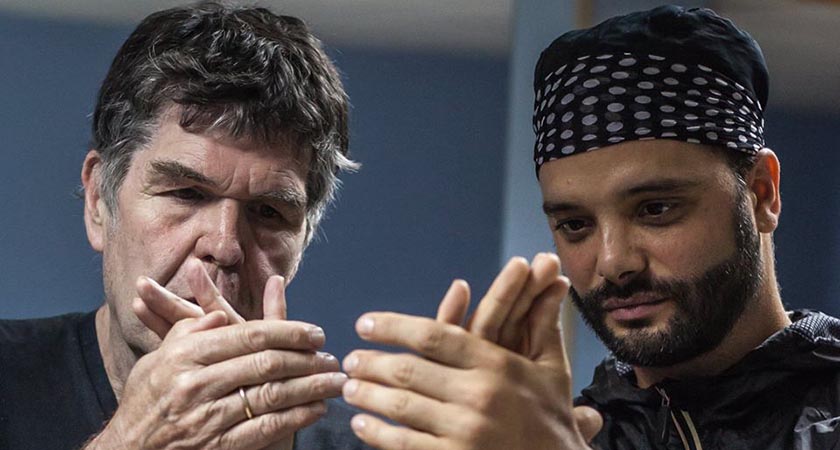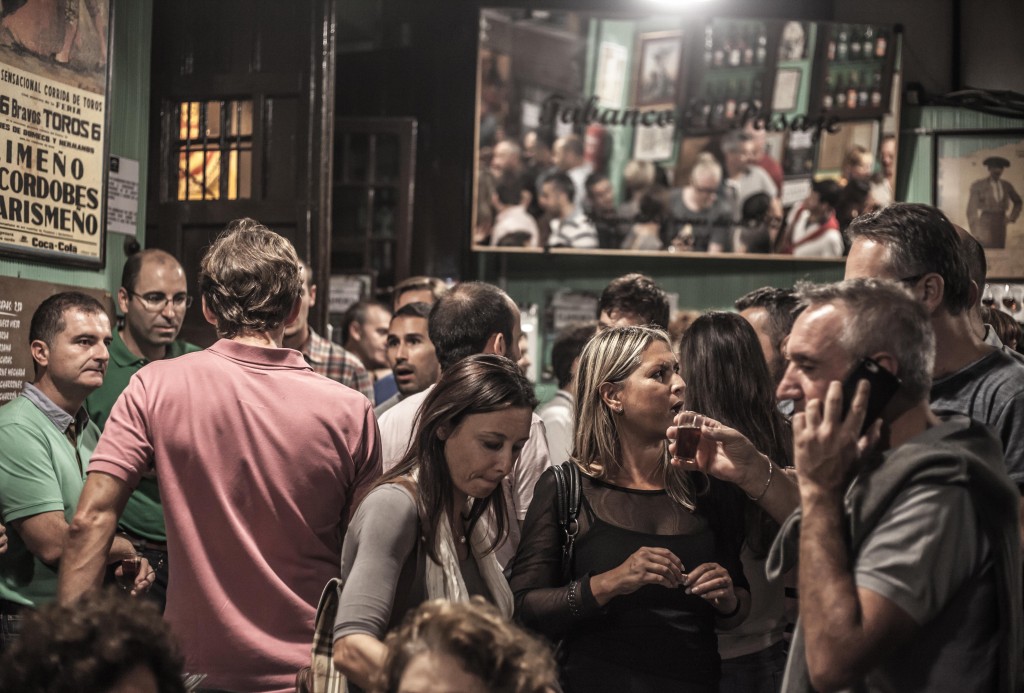WE WERE dancing with the gypsies of Spain. “Uno, doh, tray, quatro, planta, golpe.”
One, two, three, four, tap your toe, stamp. Sounds easy enough, but you also have to make graceful, artistic arm movements while your heels drill into the floor.
This was our first flamenco lesson in the Barrio de San Miguel in Jerez. One of two Gypsy, or Gitano, quarters in town, flamenco is part of the fabric of every day life hereabouts. Strictly flamenco.
 Carlos teaches our reporter Mal how to clap (Picture: Deri Robins)
Carlos teaches our reporter Mal how to clap (Picture: Deri Robins)Our teacher for the week was Carlos Carbonell, a charming Gitano, almost unacceptably handsome and lithesome. More importantly he was endlessly patient: he needed to be. In a week (two hours a day) he was to teach us the traditional Jerez dance, the buleria.
On our first day we left our hotel near the world-famous Royal School of Equitation and headed through the old town, past the white-washed walls of the bodegas, the sherry cellars, and towards San Miguel. The word sherry is of coursed derived from the name Jerez.
Most of the bodegas carry familiar names: Gonzalez Byass, Harvey, Garvey and Sandemann; the British have been guzzling sherry since Sir Francis Drake (“el Pirato” in these parts) began looting supplies in Cadiz, just down the road.
Later we’d visit the Tio Pepe bodega. Designed by Eifel, it has barrels signed by Mrs Thatcher and Picasso who both toured the premises, (although not together, sadly), and boasts the most photogenic of mice — treated to a glass of the best sherry every day.
Juan Martinez from the local tourist board explained that the long established tradition of serving local mice is a ruse, a bribe really, to keep them out of the barrels.
Juan also pointed out that Jerez produces not just sherry, but brandy, wine and vinegar. “To be honest, our vinegar is probably better than most wines you get elsewhere in Europe,” he said, pointing in the general direction of France.
We trundled past the bodegas, through the old walls, and into a tangle of mediaeval lanes lined with castle turrets, Arabic baths, former mosques, Christian cathedrals. It sometimes seems Jerez is almost too small to contain all of its clamorous history.
These streets have seen historical A-listers such as Christopher Columbus pass by. One of the crew of Columbus’s ship the Santa Maria was a local chap name of Rodrigo de Jerez.
Rodrigo has an extraordinary claim to fame — he’s credited with being the first European smoker. Sadly, there’s no statue to this brave pioneer.
The old sun-baked streets were quiet — shuttered and silent in the early afternoon heat. People round here still have that constitutionally guaranteed afternoon nap, the siesta.
We rocked along cobbled roads past the 12th-century Alcázar, a Moorish fortress, complete with honey-coloured sandstone arches.
We resisted the temptation to stop off at one of the many tapas bars en route for gazpacho and a chilled sherry, because now the spires of San Miguel were heaving into view.
 A crowded flamenco bar in Jerez (Picture: Deri Robins)
A crowded flamenco bar in Jerez (Picture: Deri Robins)San Miguel goes back to 15th century when the Gypsies were moved outside the city walls.
Our destination, El Chiqui dance school, is beside the beautiful baroque 17th century church Capilla de la Yedra; a statue of Jesus outside is overshadowed by a huge statue to famous flamenco dancer Francisca Méndez Garrido. It’s good to get your priorities right.
With a little trepidation we headed into the studio — but first-day-at-school nerves were quickly quelled. Carlos was a totally enabling teacher.
We were to learn a buleria, the flamenco dance particularly popular in Jerez. Flamenco often speaks of loss and tragedy, but here in Jerez the form is fast-paced, raucous and raunchy.
The lesson was taking shape. While totally invigorated, Deri felt her artistic interpretation left something to be desired: “He looks like he’s dancing flamenco,” she said pointing at the ever-graceful Carlos. “But I’m dancing the Birdie Song.”
My attempts were worse. I looked like a one-man Haka. But by the second day a shape to it all was emerging.
Carlos reckons that if you start from zero knowledge of flamenco, a week’s course will allow you to at least take part in a ‘circulo’; one of the ad hoc circles of dancers that form in the squares and alleyways of Jerez during one of the many festivals.
In these old cobbled squares music and dancing erupt spontaneously and will often see you through till the morning. It seems that there isn’t any words in the Jerez dialect for “calm down”.
A few words of Spanish would probably come in handy, such as “Sorry”, obviously, as well as “Here, let me help you up. I didn’t see you there.”
Most nights, after lessons, we did homework — went to a flamenco bar, or tabanco, where the seats go right up to the stage, the walls are plastered with photos of former flamenco superstars, the performers are feet away, and the wine and sherry flows free.
Because of our new found knowledge we took in one formal show: the Pura Arte Tablao Flamenco. This electrifying concert with top performers is staged nightly.
But don’t expect a sanitized touristy version of flamenco with frilly skirts and castanets. This is about passion, loss, betrayal, spirit.
The main (male) dancer looked like a taller, thinner Benedict Cumberbatch. And arrogant with it. He sneered down at the audience as if they were a plate of tortillas he hadn’t ordered.
I knew I needed to perfect my haughty look.
But funnily enough, Carlos back at El Chiqui didn’t go in for all that insolence. In between teaching us our steps and hand claps, we learnt how and when to shout “Olé!” and “Arza!” with proper Andaluz enthusiasm and abandon.
Our favourite flamenco bar was Las Cuadras in the Plaza de Asuncion. No discernible tourists were present, with everyone except ourselves speaking Spanish. Members of the audience take it in turns to sing, play guitar or dance on the stone-flagged floor of the courtyard.
You feel that if you got up to demonstrate a few Chiqui steps you’d be totally welcomed. We didn’t quite have the nerve, or enough sherry. Next year for definite.
![Dancing in Jerez [Picture: Deri Robins]](https://media.irishpost.co.uk/uploads/2016/12/Jerez-flamenco-dancing-n.jpg) Dancing in Jerez [Picture: Deri Robins]
Dancing in Jerez [Picture: Deri Robins]A short history of flamenco
The Muslims got their marching orders from Spain after the re-conquest of the country by the Christians in the 15th century.
The origins of flamenco remain obscure, but the widely-accepted explanation is that, as the Christians moved in, very quickly Gypsies, Jews, Muslims and other assorted outcasts saw he writing on the wall and scarpered to the mountains for refuge.
It appears they were expecting the Spanish Inquisition.
Here in the furnace heat of Andalucia their cultures merged and from this happy coalition flamenco emerged: singing, dancing, guitar playing, staccato clapping and finger-snapping.
The flamenco we know today had probably taken shape by the mid 1700s, and by the end of the 19th century was moving into the cafes and bars.
Fact file
Five day courses (an hour a day) from €125.
For further information click here. You'll also find useful information here.
Mal Rogers was a guest of La Patronata De Cadiz and the Spanish Tourist Board.

